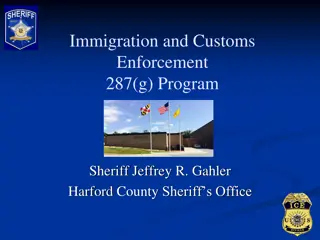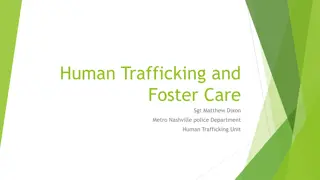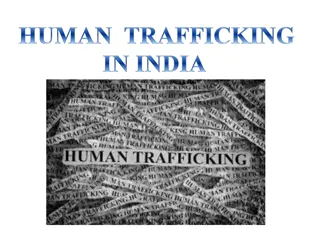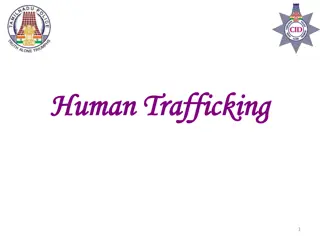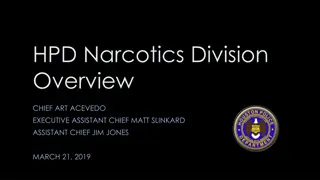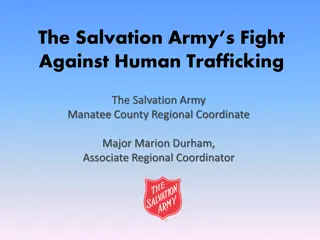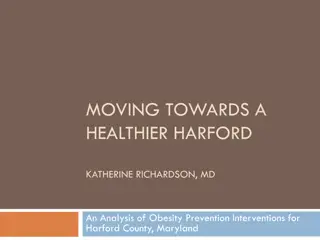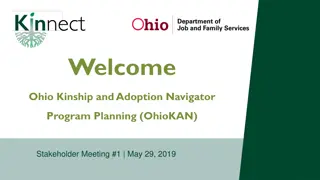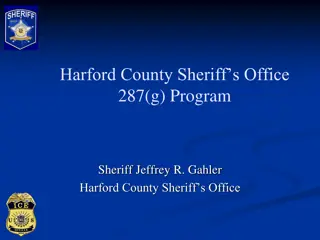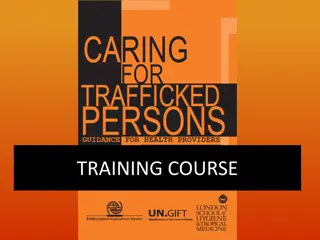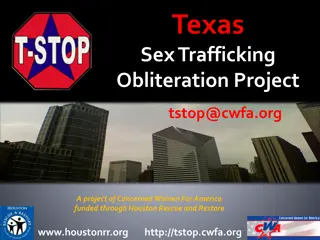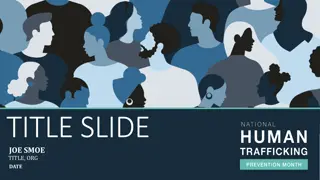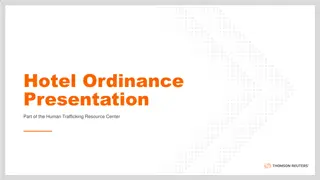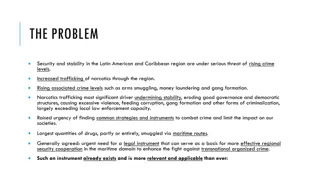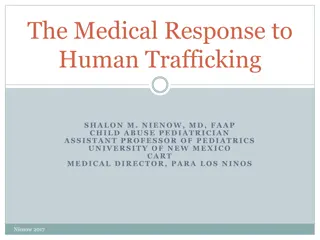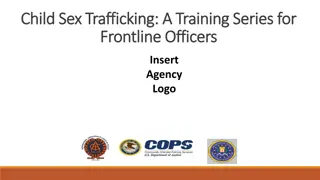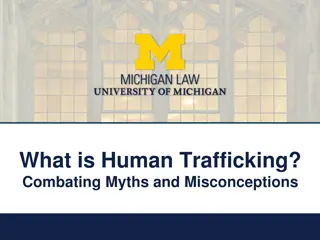Regional Trafficking Navigator Program in Harford County
Regional Trafficking Navigator Program at SARC in Harford County, Maryland, offers services for juvenile and young adult victims of sex trafficking. They provide trauma-informed safety planning, crisis services, counseling, legal assistance, advocacy, and referrals. The program aims to build effective task forces, develop protocols for services and referrals, conduct community outreach, and offer case management for victims under 24. Learn about human trafficking, victim services, and types of traffickers in the state.
Download Presentation

Please find below an Image/Link to download the presentation.
The content on the website is provided AS IS for your information and personal use only. It may not be sold, licensed, or shared on other websites without obtaining consent from the author. Download presentation by click this link. If you encounter any issues during the download, it is possible that the publisher has removed the file from their server.
E N D
Presentation Transcript
Regional Trafficking Navigator Harford County
Regional Trafficking Navigator Program at SARC Developed as a response to an identified gap in services for juvenile and young adult victims in the State of Maryland. State funded grants appointed to a service agency in each county of Maryland, in Harford County SARC. SARC provides trauma informed and victim-centered safety planning, crisis services, trauma counseling, legal services, victim advocacy, case management and referrals for community agencies. Build an effective and cooperative task force and multidisciplinary team. Develop a program and protocol for referrals and services. Provide community outreach, trainings, and educational initiatives for all community partners. Case management for all identified victims of sex trafficking under the age of 24.
Case management for victims of sex trafficking Provide emergency response to all identified victims Create safety planning Provide basic living needs Provide trauma counseling and connect client with other mental health services as needed Provide drug and alcohol abuse treatment referrals Provide legal services or connect client with appropriate representation Provide victim advocacy
What is Human Trafficking (and what is not)? Definition: The unlawful use of force, fraud, or coercion for the purpose of obtaining some kind of labor or commercial sex (except for minors). Purposes may include: Involuntary servitude, slavery, commercial sex/exploitation, peonage/debt bondage etc. Trafficking does NOT always equal transportation: Recruiting: grooming, proactive targeting of vulnerabilities Harboring: isolation, confinement/detaining, monitoring Transportation: movement/travel (interstate, transnational, cross county etc.) Smuggling is the actual transnational movement and is a crime against a country, not an individual (did forced labor or commercial sex occur during transportation?)
Providing: the act of giving (the victim) to another Obtaining: Forcibly taking or exchanging something for control Soliciting: Offering something of value (Sex only) Patronizing: Receiving something of value (Sex only) Sex and Labor trafficking are NOT mutually exclusive Types of traffickers: Romeo pimp Familial Agricultural Transnational Hospitality Child pornographer Gorilla Pimp
Understanding Commercial Sex Any sex act on account of anything of value given to any person Prostitution/Sex Work: The practice or occupation of engaging in sexual activity with someone for payment. (Sex Professional vs Survival Sex) There is no such thing as a child prostitute Trafficking as a Business Seller > Product >Buyer (many models) Trafficker/Exploiter ( Daddy Manager ) Think about how the commerce works Victims as Victimizers Vulnerability is the common denominator ( Bottom Girl Punisher ) Buyer is anyone with disposable currency Victims as profit ( Bitch Stable )
Identifying Human Trafficking (Youth and Young Adult Specific) Things to know/remember: It can happen to anyone look for intersectional vulnerabilities ( Totality of circumstances ) Sellers use Maslow s theory of needs. Discovery vs Disclosure Victims very rarely identify themselves as victims They don t care about the buyer they care about their relationship to the seller You may have a child who is being Exploited but not Trafficked. But ALL children who are trafficked are being exploited. Trauma informed: think about how early experiences filter later abuse Remember that it s normalized for the youth. Trafficked youth may not present as victims with affect Survival skills (lying, trainings loyalty to the abuser. It can be hard to get details there can be a dissociation If it s happening in their early 20 s it probably started when they were minors.
Red Flags Does the person have a history of running away, temporary homelessness, sexual abuse, long work hours? Was the youth recovered with a new cell phone, hair cut/color, nails done, nice shoes/clothes, tattoos? Is the adult doing most of the talking, controlling the interaction? What s the dynamic? Is there a significant age gap? Does the youth practice minimization or use protective language ( he doesn t know anything about that ) Does the youth have practiced answers to questions? Does the youth mix up small details? Does it appear they could be masquerading as an adult/passing off older? Pay attention to the small things: body language, truancy, frequent fliers, recants, attitudes etc.
Empowered Identification Familiarize yourself with trafficking lingo (track/blade, family/stable, the life , chose up , date, trick, stack, turn out etc.) Trust your instincts:don t discount small details the truth is in the minutiae. Remember that these victims rarely present like stereotype victims they are trained to protect their abusers at all costs. Best practices: Build rapport/trust, ask open ended questions, don t try to coerce into giving information, respect self-determination, make yourself safe and accessible, take lots of detailed notes! If you suspect: get another set of ears/eyes to talk through the situation with you. Someone else might have thoughts or see things you re missing. Always remember, these kids and young adults are fiercely strong, remarkable survivors!
How To Report Human Trafficking If you are suspicious of any activities involving minors, contact law enforcement. If you are concerned a child is being trafficked while in foster care, contact local child protection services. If a child is a multiple-time runaway, make a runaway report to law enforcement and direct their attention to the history of that behavior and your suspicion of trafficking. Contact the Human Trafficking National hotline 1-888-373-7888 If you encounter youths you believe are being trafficked for commercial sex: Do not approach them they are potentially being watched. Notify police and make as many detailed notes as you can about the situation. If you suspect transnational trafficking, DO NOT contact ICE, instead consult the national hotline.
Questions? For more information on SARC s Human Trafficking Program: Abi Montgomery Phone number 410-836-8430 Amontgomery@sarc-Maryland.org




